Sleeping Around: India Hotel Reviews
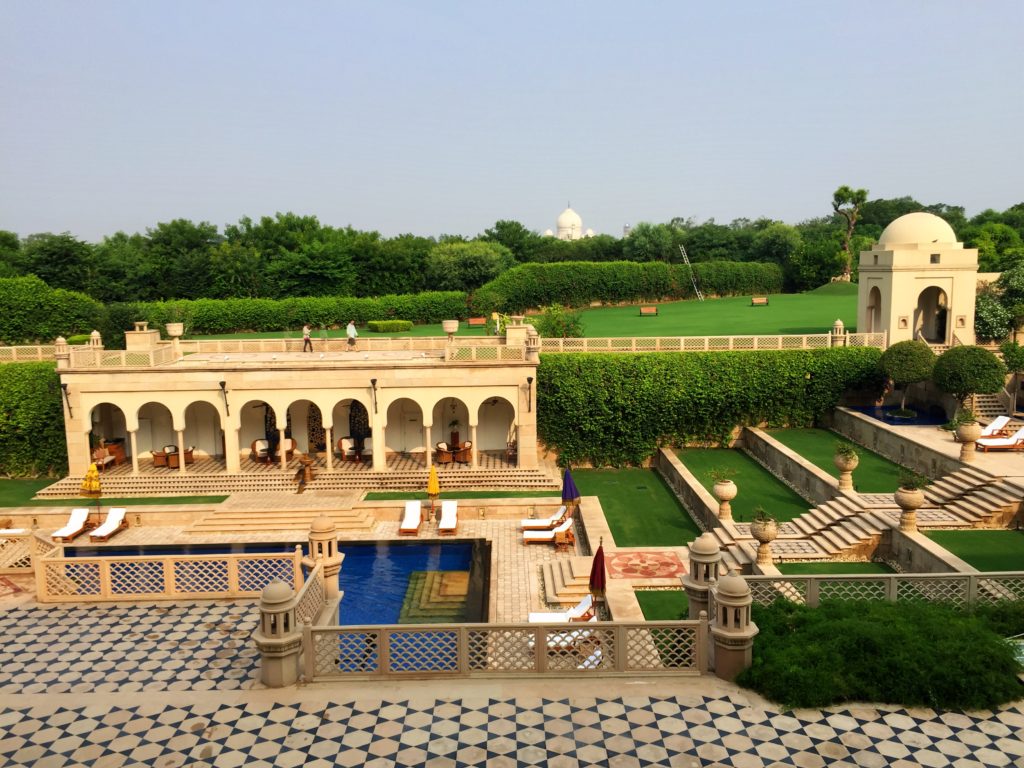 Looking out to The Taj Mahal from The Oberoi Amarvilas.
Looking out to The Taj Mahal from The Oberoi Amarvilas.
I recently found myself in Northern India, wandering the crowded, bustling streets by day and drenched in luxury at night in a country with a story of occupation, then freedom. It’s undeniable how much history has influenced all of these hotel properties whether it be the former residents, the design or the staff, who take pride in teaching you about their culture. Whether you find yourself in the insanely overpopulated cities of Delhi and Mumbai or the “smaller”, brilliantly colored cities through the northern state of Rajasthan, these are the most jaw dropping places and palaces to rest your head after a dizzying and exhilarating day zipping down bustling city streets and dirt narrows by tuk tuk.
DELHI
The Leela, New Delhi: The open lobby is adorned with crystal vases and bright roses. At any given time, there are 14,000 roses throughout the hotel, 500 of which are arranged in the lobby’s silver centerpiece. The Leela New Delhi is the right combination of international flare (Le Cirque serves dinner to celebs and socialites) and cultural awareness (there is a female-only floor for traditional travelers of Eastern culture). What impressed me the most was the service, ever-present, from calling the elevator to pouring more tea at breakfast, my every need was anticipated.
The Oberoi, Gurgaon: Although just 15 minutes from Delhi International, this is far from what you’d think of as an “airport hotel”. The Oberoi Gurgaon is an ultra modern, sleek property divided into three blocks: hotel, residence and conference center. The 220 hotel rooms all have private butler service and not just any ol’ service, but rather trained by the same school as Queen of England’s butlers. So it’s safe to say, it’s literally fit for a queen…or Maharani, as a princess is called in India.
ThreeSixtyOne, the hotel’s restaurant, has a chocolate cake that is a must. But don’t worry, the gym and spa are 24/7 hours so your indulgence can be (almost) guilt-free. Dine on Indian, Asian and continental cuisines.
 The welcome from staff upon stepping into The Oberoi Amarvilas’ courtyard.
The welcome from staff upon stepping into The Oberoi Amarvilas’ courtyard.
AGRA
The Oberoi, Amarvilas: If you’re visiting the Taj Mahal, a white marble symbol of an emperor’s love for his favorite(!) wife, which you should if you’re visiting northern India, you MUST stay at The Oberoi Amarvilas. It’s an oasis in Agra, a city where India’s harsh poverty isn’t lost. This ancient wonder of the world and UNESCO site can be seen from every suite. Soaking in a bubble bath while gazing at the setting sun over the Taj Mahal…now that’s romantic. Amarvilas is ideal for two to three nights of relaxation in the midst of your Indian journey. The idyllic setting will be welcome after days of visiting massive mausoleums, forts and temples in the beating sun. You’ll need a full day to just take in the vast pool, multi-tiered lounging decks and manicured gardens.
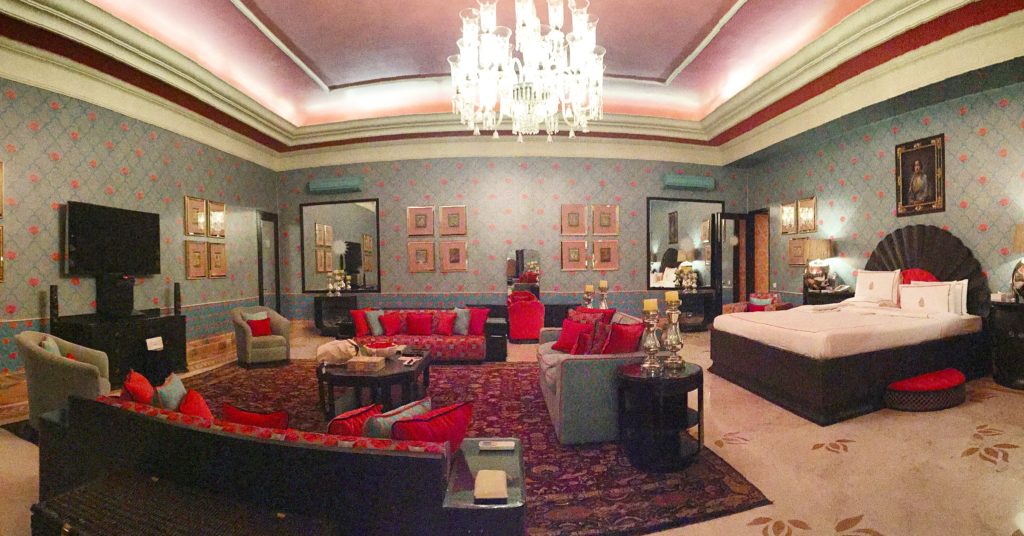 Just part of the Maharani suite at Suján Rajmahal.
Just part of the Maharani suite at Suján Rajmahal.
JAIPUR
Suján Rajmahal: Rajmahal, a former British Residence and then private home of the Mahajara, boasts just 14 suites, all differing in decor and size, and aptly named. The Princess Diana suite, delicately decorated in blues and whites, is where the late royalty stayed when visiting the palace. The Maharani suite, second largest on property only to the Maharaja suite, is the former chamber of the Maharani and boasts a well-lit, massive bathroom, plenty of mirrored closets and a private pool. True to it’s name, it’s fit for a princess! It’s also where I got to call home for two nights (and recently, so did this Forbes writer). The bold teal and fuchsia wall coverings and upholstery make for an opulent atmosphere. The rich and fun colors are woven throughout the property’s decor.
Rajmahal feels like your own private palace. (It almost is with so few other guests!) And as silly as it sounds, I can’t stop craving the sweet corn-like muffins and mini slices of pound cake. Just a week after my stay here, the palace was given Relais & Châteaux accolades, only given to properties that embody the culture, people and history of its surroundings. Over the next year, the property will be almost tripling to 40 suites.
 One of Rambagh’s meticulous gardens and courtyards.
One of Rambagh’s meticulous gardens and courtyards.
Rambagh Palace: Rambagh is synonymous with regal, with its grand entrance and outdoor halls overlooking vast courtyards and richly decorated suites. India’s history is apparent throughout Rambagh, from photos of the former royal tenants to the polo lounge honoring the days the property hosted the sport. If you’re looking to indulge in luxury and learn along the way, a suite here is where to stay.
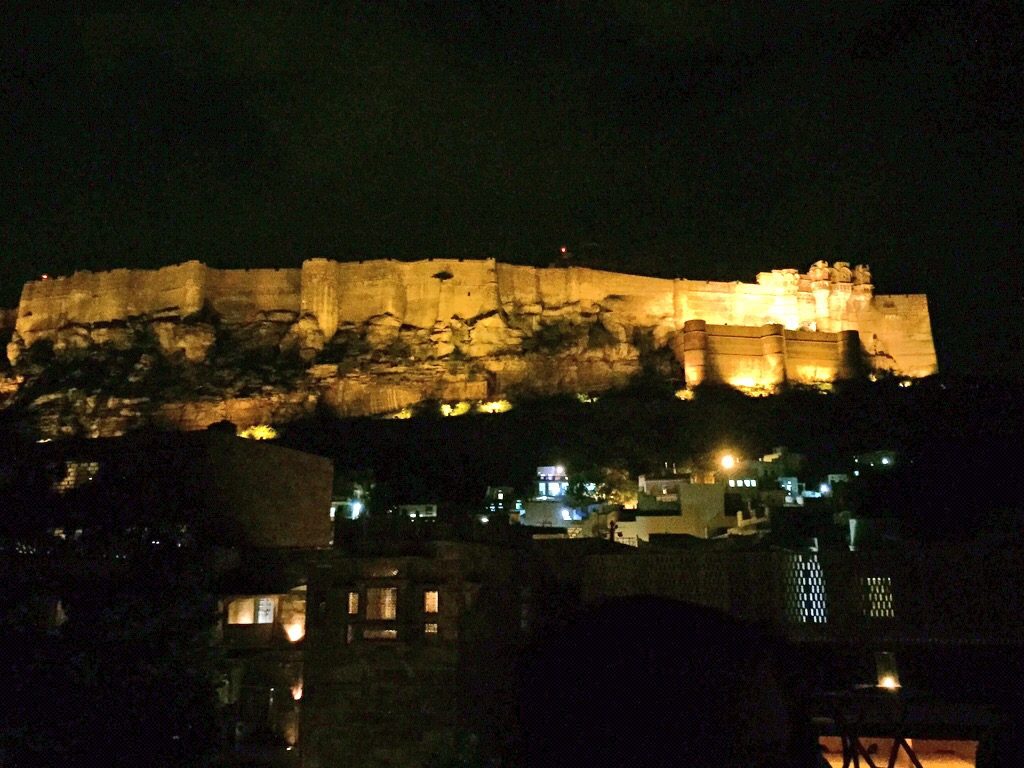 Mehrangarh Fort illuminated above RAAS.
Mehrangarh Fort illuminated above RAAS.
JODHPUR
RAAS: With crisp white sheets and a comfortable bed, this is where you will rise to a deep-voiced, pre-dawn prayer echoing through the blue, walled city. The property is built from local Jodhpur pink sandstone and gives a welcomed juxtaposition to the cool hue of the rest of the city. Peek through scalloped open-air windows for an unobstructed view of the Mehrangarh Fort, seemingly an arm’s length away.
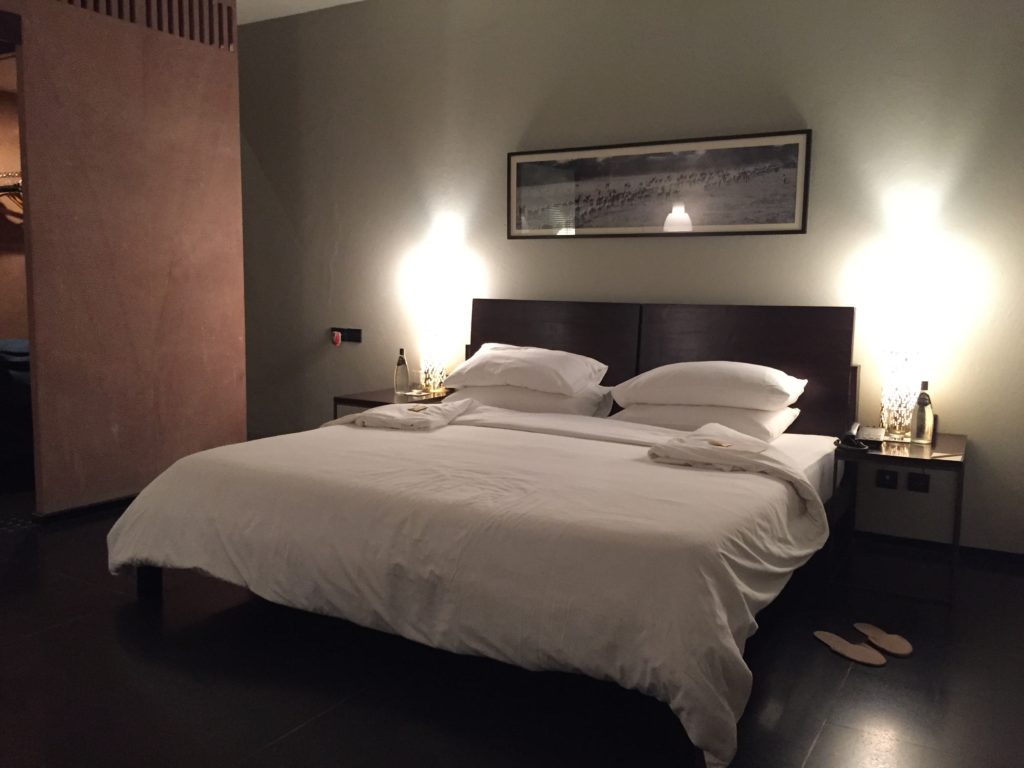 Simple luxury and pink sandstone at RAAS.
Simple luxury and pink sandstone at RAAS.
MUMBAI
Taj Mahal Palace: Never has there been a more appropriate name of “Presidential Suite” than Taj Mahal’s, the waterfront property in Mumbai, not to be confused with the iconic Agra mausoleum. President Obama was the first to stay in the 5,000 sq. ft. suite, which is large enough to get lost in (which I did), has bullet proof glass, a 12-person conference room and private spa, to relax in after those day-long meetings making decisions that impact the world. For those of us outside the Oval Office, Taj has not quite as large but equally exquisite suites that overlook The Gateway to India, a monument symbolizing both the British rule and India’s freedom. I particularly enjoyed the bathrooms with claw-foot soaking tubs reminiscent of colonial times and double vanities.
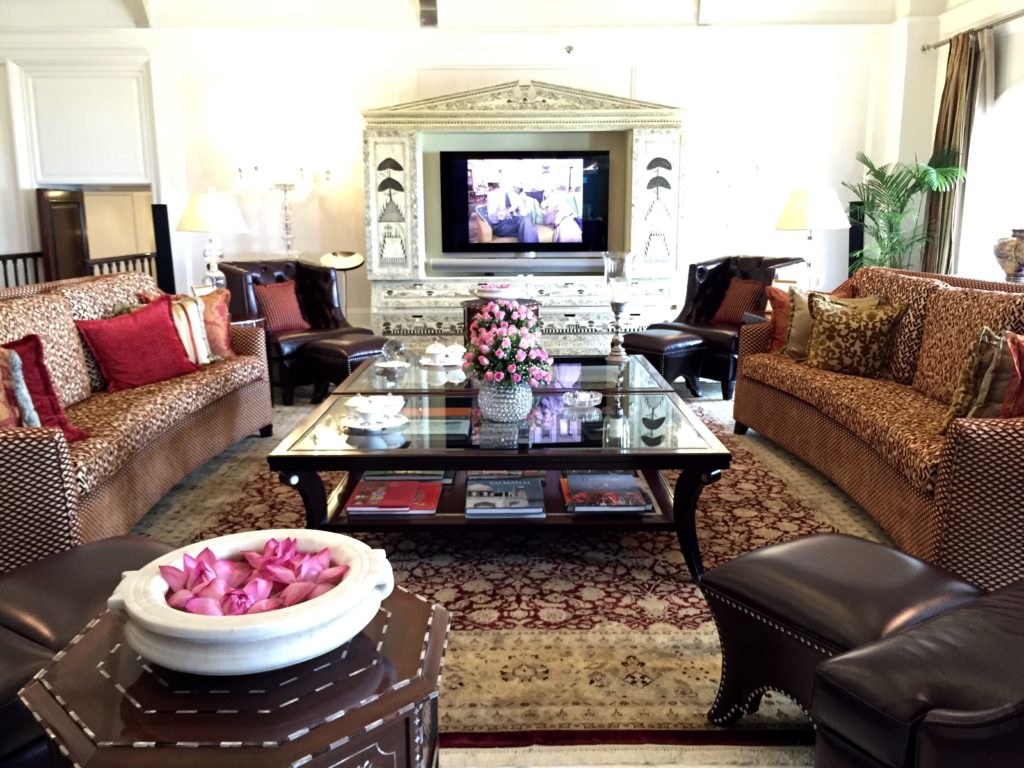 Taj’s Presidential Suite, former guest: Barack Obama.
Taj’s Presidential Suite, former guest: Barack Obama.
The Oberoi Mumbai: This Oberoi gets it right on all accounts: anticipatory service, sleek, sophisticated design, and convenient city location. A near and dear property to owner Mr. Oberoi’s heart, he personally redesigned and oversaw the hotel’s reconstruction when it was closed from 2008-2010 after the 2008 terrorist bombing. Expect the edge of a modern city with elements like a red lacquer baby grand as the focal point of the lobby. A wall of windows and full-ceiling skylights brighten the space and look out to the Arabian Sea. Rooms are crisp and clean, designed tastefully with contemporary paintings and statues. And a 24-hour spa- the only in the city.
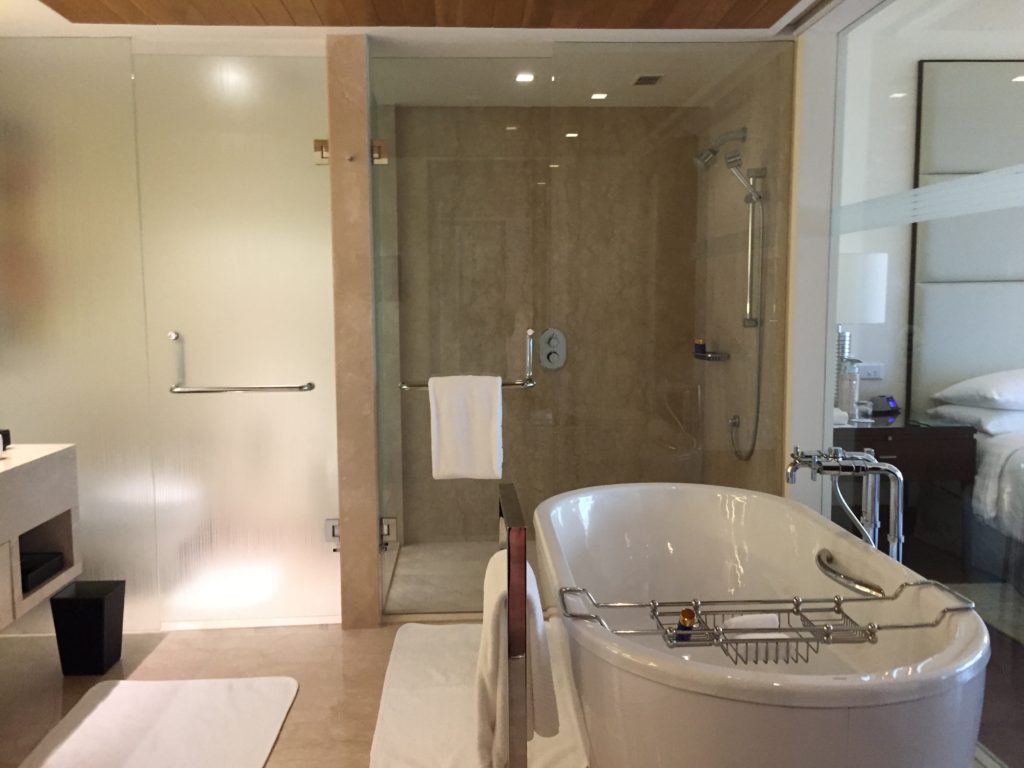 A large bathroom with luxurious free standing tub and glass walls at The Oberoi Mumbai.
A large bathroom with luxurious free standing tub and glass walls at The Oberoi Mumbai.
For more on how to support the local people sustainably, read about Nikki’s visit to Salaam Baalak Foundation in Delhi.
